Abstract
BACKGROUND: There are many different methods by which trainees may be assessed summatively. AIM: The objective of the study was to determine if videotaped consultations could be used to identify reliably those general practitioner trainees who have not yet reached acceptable levels of competence. METHOD: Videotapes of 10 trainees carrying out normal consultations were assessed by 20 assessors for acceptable competence using a rating scale specifically developed for the purpose. RESULTS: A principal components analysis showed a strong correlation among the items in the rating scale used, indicating that a single underlying factor accounted for 76% of the overall scores. Agreement between assessors on the scoring of individual consultations was limited. There was much greater consistency with regard to the decision on overall competence, examined for the first consultation. A non-competent trainee would have a 95% probability of being identified by the process as described using two assessors for each videotape. The assessors had reached firm judgements on each trainee by the time four consultations had been viewed. CONCLUSION: The workload involved in producing and analysing the tapes is discussed. Considerations of patient consent are addressed. It is concluded that the use of videotaped consultations appears to offer a feasible and reliable method of summative assessment of general practitioner trainees.
Full text
PDF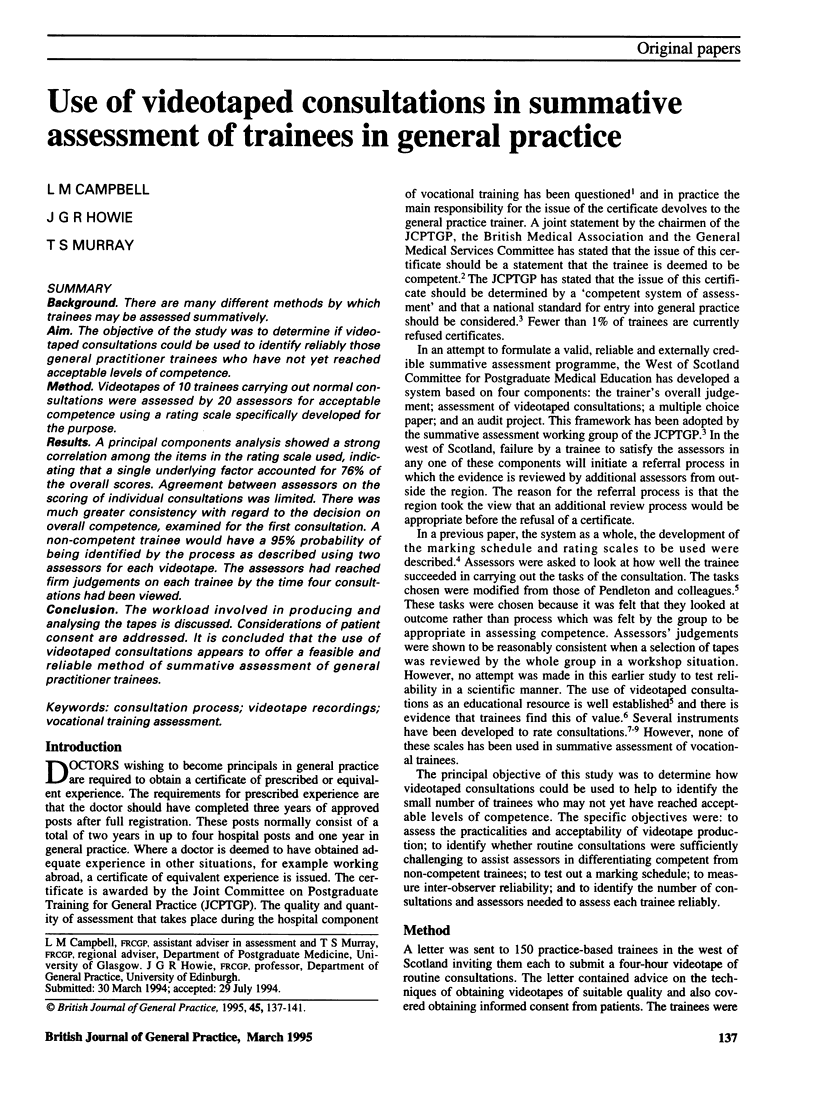
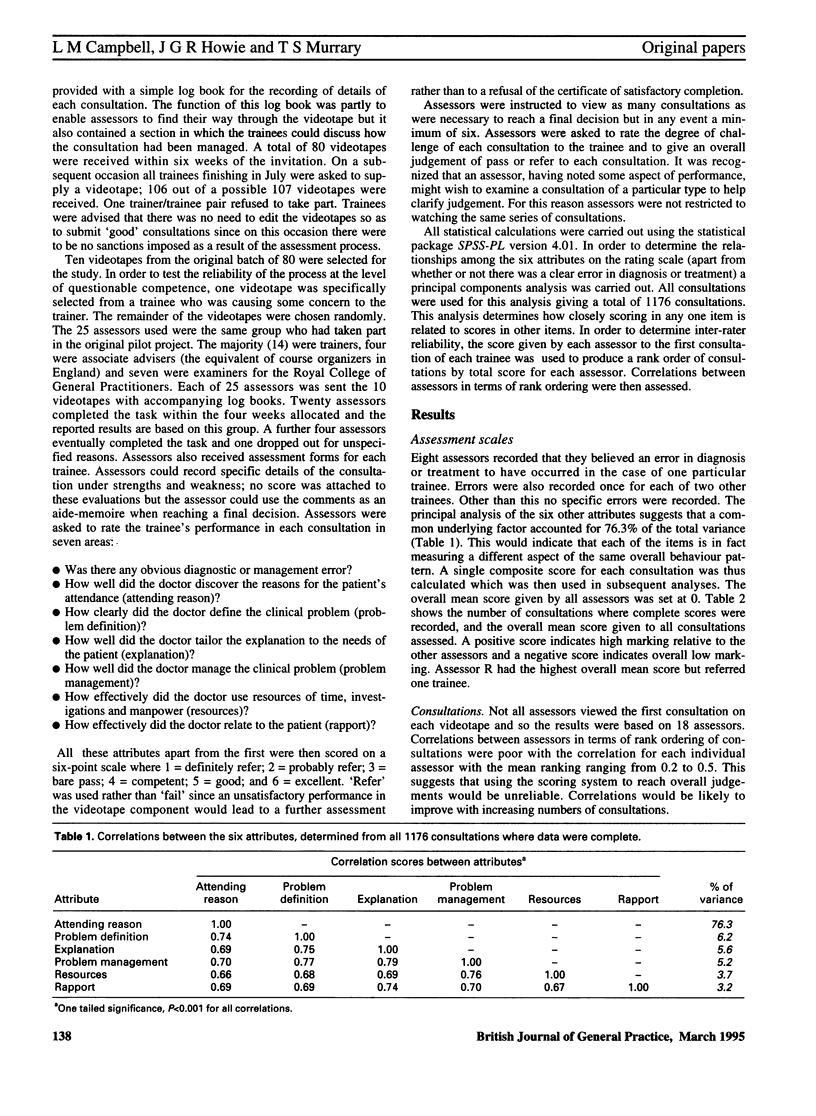
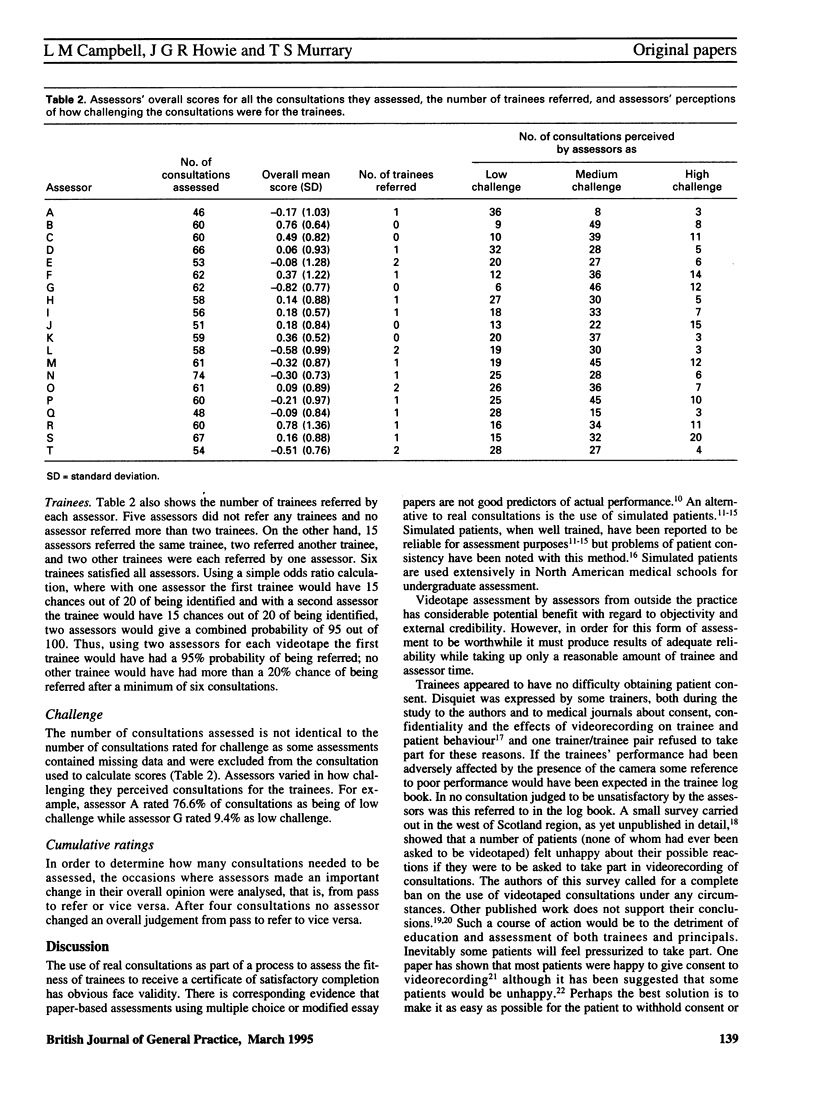
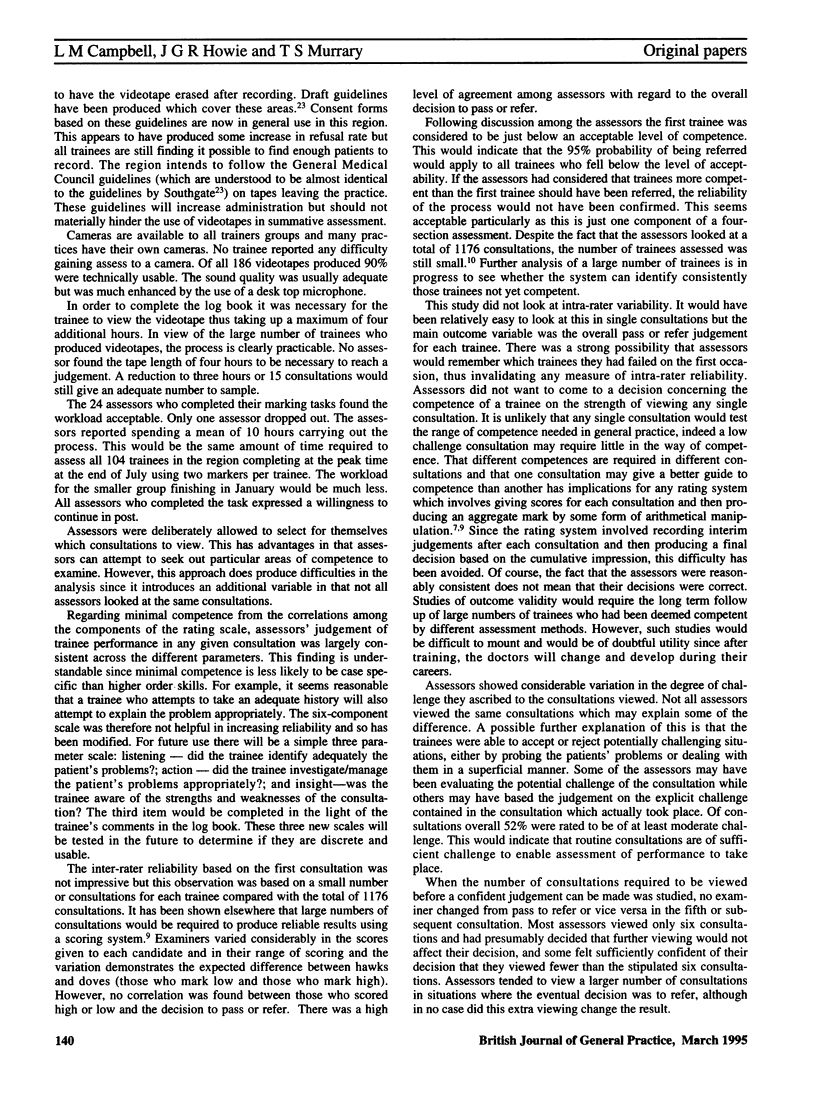
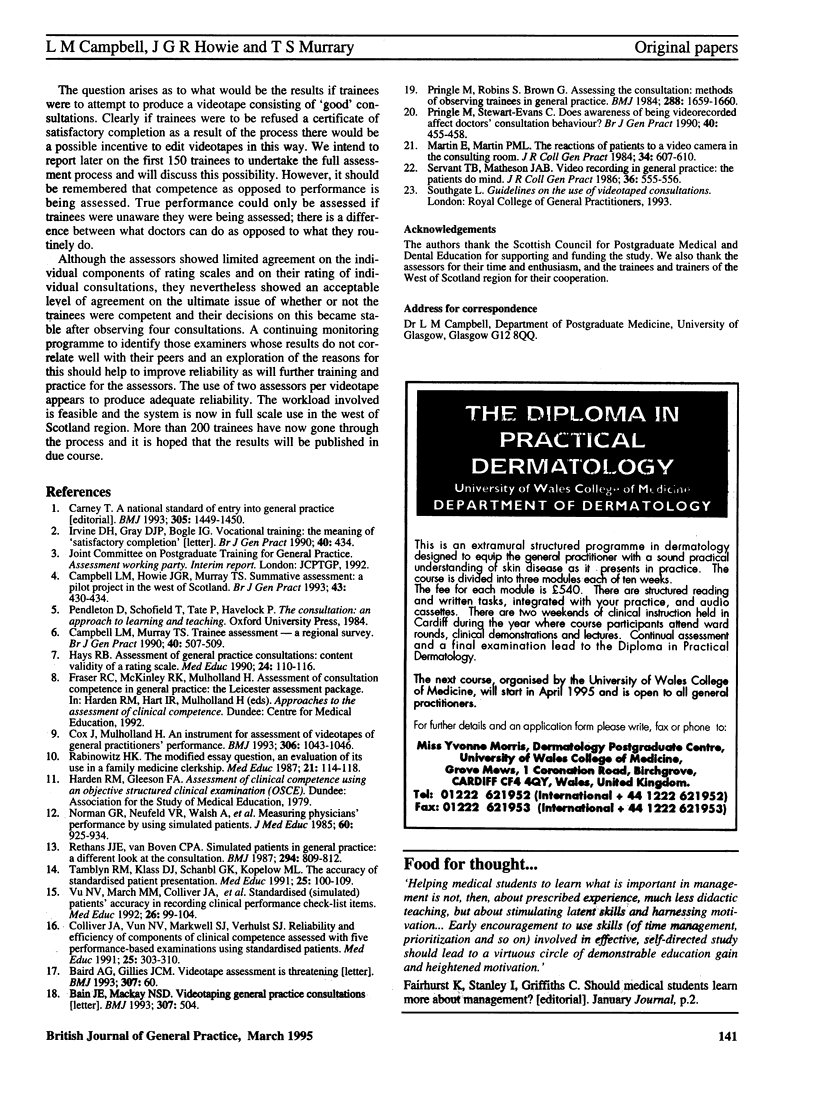
Selected References
These references are in PubMed. This may not be the complete list of references from this article.
- Bain J. E., Mackay N. S. Videotaping general practice consultations. BMJ. 1993 Aug 21;307(6902):504–505. doi: 10.1136/bmj.307.6902.504-b. [DOI] [PMC free article] [PubMed] [Google Scholar]
- Baird A. G., Gillies J. C. Assessing GPs' performance. Videotape assessment is threatening. BMJ. 1993 Jul 3;307(6895):60–60. doi: 10.1136/bmj.307.6895.60-a. [DOI] [PMC free article] [PubMed] [Google Scholar]
- Campbell L. M., Howie J. G., Murray T. S. Summative assessment: a pilot project in the west of Scotland. Br J Gen Pract. 1993 Oct;43(375):430–434. [PMC free article] [PubMed] [Google Scholar]
- Campbell L. M., Murray T. S. Trainee assessment--a regional survey. Br J Gen Pract. 1990 Dec;40(341):507–509. [PMC free article] [PubMed] [Google Scholar]
- Carney T. A national standard for entry into general practice. BMJ. 1992 Dec 12;305(6867):1449–1450. doi: 10.1136/bmj.305.6867.1449. [DOI] [PMC free article] [PubMed] [Google Scholar]
- Colliver J. A., Vu N. V., Markwell S. J., Verhulst S. J. Reliability and efficiency of components of clinical competence assessed with five performance-based examinations using standardized patients. Med Educ. 1991 Jul;25(4):303–310. doi: 10.1111/j.1365-2923.1991.tb00071.x. [DOI] [PubMed] [Google Scholar]
- Cox J., Mulholland H. An instrument for assessment of videotapes of general practitioners' performance. BMJ. 1993 Apr 17;306(6884):1043–1046. doi: 10.1136/bmj.306.6884.1043. [DOI] [PMC free article] [PubMed] [Google Scholar]
- Hays R. B. Assessment of general practice consultations: content validity of a rating scale. Med Educ. 1990 Mar;24(2):110–116. doi: 10.1111/j.1365-2923.1990.tb02508.x. [DOI] [PubMed] [Google Scholar]
- Martin E., Martin P. M. The reactions of patients to a video camera in the consulting room. J R Coll Gen Pract. 1984 Nov;34(268):607–610. [PMC free article] [PubMed] [Google Scholar]
- Norman G. R., Neufeld V. R., Walsh A., Woodward C. A., McConvey G. A. Measuring physicians' performances by using simulated patients. J Med Educ. 1985 Dec;60(12):925–934. doi: 10.1097/00001888-198512000-00004. [DOI] [PubMed] [Google Scholar]
- Pringle M., Robins S., Brown G. Assessing the consultation: methods of observing trainees in general practice. Br Med J (Clin Res Ed) 1984 Jun 2;288(6431):1659–1660. doi: 10.1136/bmj.288.6431.1659. [DOI] [PMC free article] [PubMed] [Google Scholar]
- Pringle M., Stewart-Evans C. Does awareness of being video recorded affect doctors' consultation behaviour? Br J Gen Pract. 1990 Nov;40(340):455–458. [PMC free article] [PubMed] [Google Scholar]
- Rabinowitz H. K. The modified essay question: an evaluation of its use in a family medicine clerkship. Med Educ. 1987 Mar;21(2):114–118. doi: 10.1111/j.1365-2923.1987.tb00676.x. [DOI] [PubMed] [Google Scholar]
- Rethans J. J., van Boven C. P. Simulated patients in general practice: a different look at the consultation. Br Med J (Clin Res Ed) 1987 Mar 28;294(6575):809–812. doi: 10.1136/bmj.294.6575.809. [DOI] [PMC free article] [PubMed] [Google Scholar]
- Servant J. B., Matheson J. A. Video recording in general practice: the patients do mind. J R Coll Gen Pract. 1986 Dec;36(293):555–556. [PMC free article] [PubMed] [Google Scholar]
- Tamblyn R. M., Klass D. J., Schnabl G. K., Kopelow M. L. The accuracy of standardized patient presentation. Med Educ. 1991 Mar;25(2):100–109. doi: 10.1111/j.1365-2923.1991.tb00035.x. [DOI] [PubMed] [Google Scholar]
- Vu N. V., Marcy M. M., Colliver J. A., Verhulst S. J., Travis T. A., Barrows H. S. Standardized (simulated) patients' accuracy in recording clinical performance check-list items. Med Educ. 1992 Mar;26(2):99–104. doi: 10.1111/j.1365-2923.1992.tb00133.x. [DOI] [PubMed] [Google Scholar]


